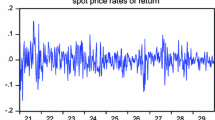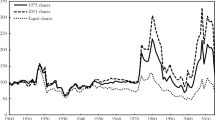Abstract
We propose an empirical commodity market model with heterogeneous speculators. While the power of trend-extrapolating chartists is constant over time, the symmetric impact of stabilizing fundamentalists adjusts endogenously according to market circumstances: Using monthly data for various commodities such as cotton, sugar or zinc, our STAR–GARCH model indicates that their influence positively depends on the distance between the commodity price and its long-run equilibrium value. Fundamentalists seem to become more and more convinced that mean reversion will set in as the mispricing enlarges. Commodity price cycles may thus emerge due to the nonlinear interplay between different trader types.
Similar content being viewed by others
References
Bollerslev T, Wooldridge J (1992) Quasi maximum likelihood estimation and inference in dynamic models with time varying covariances. Econometric Rev 11:143–172
Borenzstein E, Khan M, Reinhart C, Wickham P (1994) The behavior of non-oil commodity prices. IMF Occasional Paper 112, IMF, Washington
Brock W, Hommes C (1997) A rational route to randomness. Econometrica 65:1059–1095
Brock W, Hommes C (1998) Heterogeneous beliefs and routes to chaos in a simple asset pricing model. J Econ Dyn Control 22:1235–1274
Canoles B, Thompson S, Irwin S, France V (1998) An analysis of the profiles and motivations of habitual commodity speculators. J Futures Mark 18:765–801
Cashin P, McDermott J, Scott A (2002) Booms and slumps in world commodity prices. J Dev Econ 69:277–296
Chiarella C, Iori G (2002) A simulation analysis of the of the microstructure of double auction markets. Quant Finance 2:1–8
Chiarella C, Dieci R, Gardini, L (2002) Speculative behavior and complex asset price dynamics. J Econ Behav Orgn 49:173–197
Day R (1994) Complex economic dynamics: An introduction to dynamical systems and market mechanisms. MIT Press, Cambridge
Day R, Huang W (1990) Bulls, bears and market sheep. J Econ Behav Org 14:299–329
Deaton A (1999) Commodity prices and growth in Africa. J Econ Perspect 13:23–40
Deaton A, Laroque G (1992) On the behavior of commodity prices. Rev Econ Stud 59:1–24
De Grauwe P, Dewachter H, Embrechts M (1993) Exchange rate theory: chaotic models of foreign exchange markets. Blackwell, Oxford
Draper D (1985) The small public trader in futures markets. In: Peck A (ed) Futures markets: regulatory issues. American Enterprise Institute for Public Policy Research, Washington 211–269
Eitrheim O, Teräsvirta T (1996) Testing the adequacy of smooth transition autoregressive models. J Econ 74:59–75
Farmer D, Joshi S (2002) The price dynamics of common trading strategies. J Econ Behav Org 49:149–171
Granger C, Teräsvirta T (1993) Modelling nonlinear economic relationships. Oxford University Press, Oxford
Hommes C (1998) On the consistency of backward-looking expectations: The case of the cobweb. J Econ Behav Org 33:333–362
Hommes C (2001) Financial markets as nonlinear adaptive evolutionary systems. Quant Finance 1:149–167
Kahneman D, Slovic P, Tversky A (1986) Judgment under uncertainty: heuristics and biases. Cambridge University Press, Cambridge
Kilian L, Taylor M (2003) Why is it so difficult to beat the random walk forecast of exchange rates? J Int Econ 60:85–107
Kirman A (1991) Epidemics of opinion and speculative bubbles in financial markets. In: Taylor M (ed) Money and financial markets. Blackwell, Oxford:354–368
LeBaron B, Arthur B, Palmer R (1999) Time series properties of an artificial stock market. J Econ Dyn Control 23:1487–1516
Ljung G, Box G (1978) On a Measure of Lack of Fit in Time Series Models. Biometrika 67:297–303
Lundbergh S, Teräsvirta T (1998) Modeling economic high frequency time series with STAR–STGARCH models. Stockholm School of Economics WP No 291
Lux T (2004) Financial power laws: empirical evidence, models, and mechanisms. University of Kiel, mimeo
Lux T, Marchesi M (2000) Volatility clustering in financial markets: A micro-simulation of interacting agents. International J Theor Appl Finance 3:675–702
Menkhoff L (1997) Examining the use of technical currency analysis. Int J Finance Econ 2:307–318
Murphy J (1999) Technical analysis of financial markets. New York Institute of Finance, New York
Nam K, Pyun C, Avard S (2001) Asymmetric reverting behavior of short-horizon stock returns: an evidence of stock market overreaction. J Bank Finance 25:807–824
Nam K, Pyun C, Arize A (2002) Asymmetric mean-reversion and contrarian profits: ANST-GARCH approach. J Empirical Finance 9:563–588
Rosser J, Ahmed E, Hartmann G (2003) Volatility via social flaring. J Econ Behav Org 50:77–87
Sanders D, Irwin S, Leuthold R (2000) Noise trader sentiment in futures markets. In: Goss B. (eds). Models of futures markets. Routledge, pp 86–116
Sarantis N (1999) Modeling non-linearities in real effective exchange rates. J Int Money Finance 18:27–45
Smidt S (1965) Amateur speculators: A survey of trading strategies, information sources and patterns of entry and exit from commodity futures markets by non-professional speculators. Cornell Studies in Policy and Administration, Cornell University
Smith V (1991) Papers in experimental economics. Cambridge University Press, Cambridge
Sonnemans J, Hommes C, Tuinstra J, van de Velden H (2004) The instability of a heterogeneous cobweb economy: a strategy experiment on expectation formation. J Econ Behav Org 54:453–481
Taylor M, Allen H (1992) The use of technical analysis in the foreign exchange market. J Int Money Finance 11:304–314
Teräsvirta T (1994) Specification, estimation, and evaluation of smooth transition autoregressive models. J Am Stat Assoc 89:208–218
Teräsvirta T, Anderson H (1992) Characterizing nonlinearities in business cycles using smooth transition autoregressive models. J Appl Econom 7:119–139
Weiner R (2002) Sheep in wolves’ clothing? Speculators and price volatility in petroleum futures. Q Rev Econ Finance 42:391–400
Author information
Authors and Affiliations
Corresponding author
Additional information
The paper represents the authors’ personal opinion and does not necessarily reflect the views of the Deutsche Bundesbank.
Rights and permissions
About this article
Cite this article
Reitz, S., Westerhoff, F. Commodity price cycles and heterogeneous speculators: a STAR–GARCH model. Empirical Economics 33, 231–244 (2007). https://doi.org/10.1007/s00181-006-0100-7
Received:
Accepted:
Published:
Issue Date:
DOI: https://doi.org/10.1007/s00181-006-0100-7




